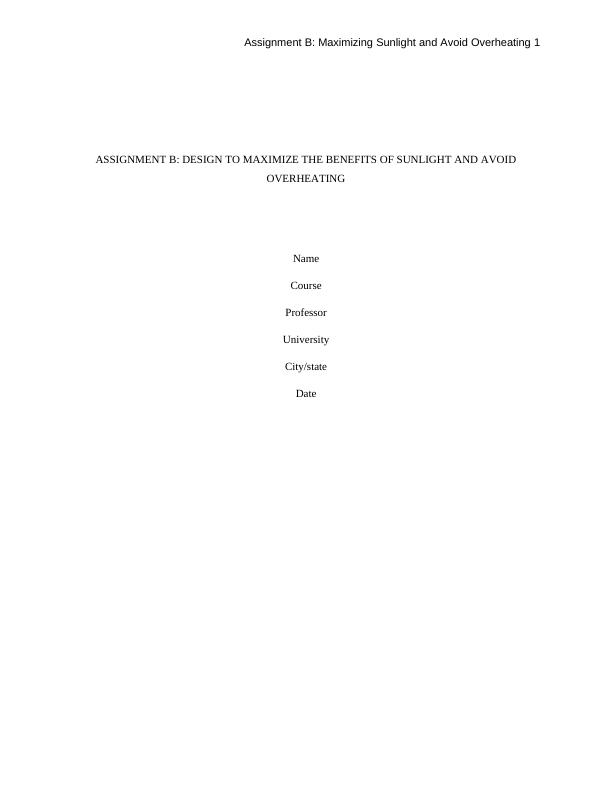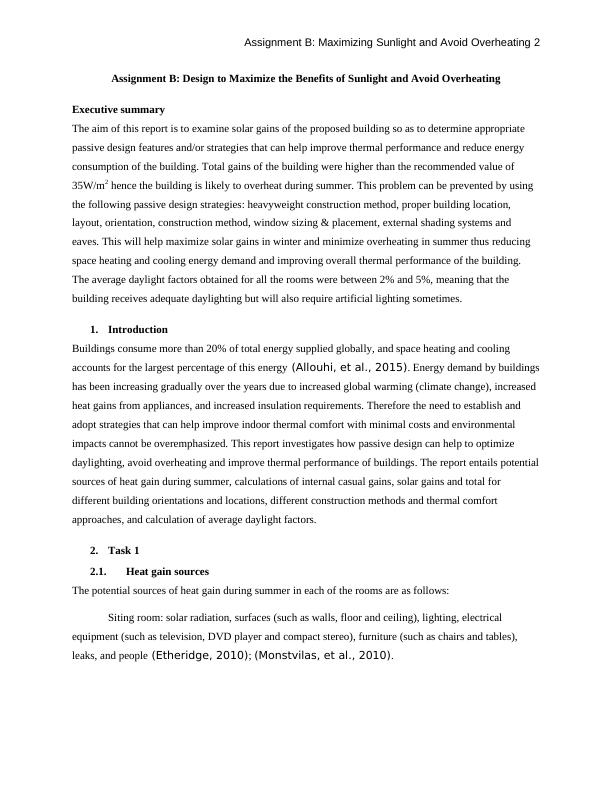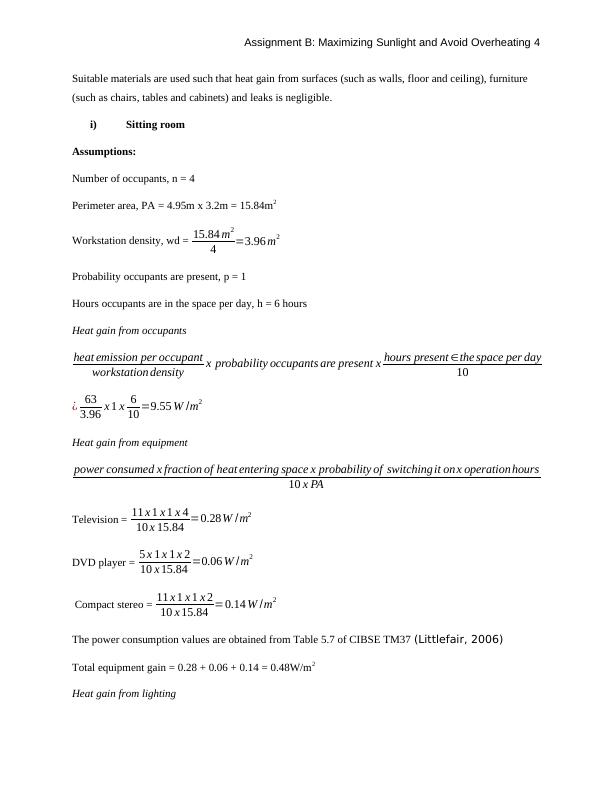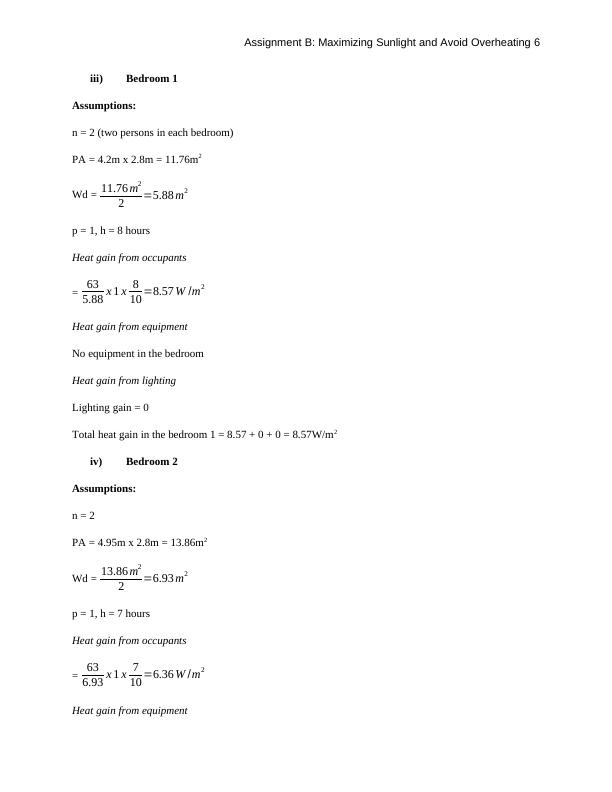Maximizing Sunlight and Avoid Overheating
Added on 2023-01-03
28 Pages7410 Words97 Views
Assignment B: Maximizing Sunlight and Avoid Overheating 1
ASSIGNMENT B: DESIGN TO MAXIMIZE THE BENEFITS OF SUNLIGHT AND AVOID
OVERHEATING
Name
Course
Professor
University
City/state
Date
ASSIGNMENT B: DESIGN TO MAXIMIZE THE BENEFITS OF SUNLIGHT AND AVOID
OVERHEATING
Name
Course
Professor
University
City/state
Date

Assignment B: Maximizing Sunlight and Avoid Overheating 2
Assignment B: Design to Maximize the Benefits of Sunlight and Avoid Overheating
Executive summary
The aim of this report is to examine solar gains of the proposed building so as to determine appropriate
passive design features and/or strategies that can help improve thermal performance and reduce energy
consumption of the building. Total gains of the building were higher than the recommended value of
35W/m2 hence the building is likely to overheat during summer. This problem can be prevented by using
the following passive design strategies: heavyweight construction method, proper building location,
layout, orientation, construction method, window sizing & placement, external shading systems and
eaves. This will help maximize solar gains in winter and minimize overheating in summer thus reducing
space heating and cooling energy demand and improving overall thermal performance of the building.
The average daylight factors obtained for all the rooms were between 2% and 5%, meaning that the
building receives adequate daylighting but will also require artificial lighting sometimes.
1. Introduction
Buildings consume more than 20% of total energy supplied globally, and space heating and cooling
accounts for the largest percentage of this energy (Allouhi, et al., 2015). Energy demand by buildings
has been increasing gradually over the years due to increased global warming (climate change), increased
heat gains from appliances, and increased insulation requirements. Therefore the need to establish and
adopt strategies that can help improve indoor thermal comfort with minimal costs and environmental
impacts cannot be overemphasized. This report investigates how passive design can help to optimize
daylighting, avoid overheating and improve thermal performance of buildings. The report entails potential
sources of heat gain during summer, calculations of internal casual gains, solar gains and total for
different building orientations and locations, different construction methods and thermal comfort
approaches, and calculation of average daylight factors.
2. Task 1
2.1. Heat gain sources
The potential sources of heat gain during summer in each of the rooms are as follows:
Siting room: solar radiation, surfaces (such as walls, floor and ceiling), lighting, electrical
equipment (such as television, DVD player and compact stereo), furniture (such as chairs and tables),
leaks, and people (Etheridge, 2010); (Monstvilas, et al., 2010).
Assignment B: Design to Maximize the Benefits of Sunlight and Avoid Overheating
Executive summary
The aim of this report is to examine solar gains of the proposed building so as to determine appropriate
passive design features and/or strategies that can help improve thermal performance and reduce energy
consumption of the building. Total gains of the building were higher than the recommended value of
35W/m2 hence the building is likely to overheat during summer. This problem can be prevented by using
the following passive design strategies: heavyweight construction method, proper building location,
layout, orientation, construction method, window sizing & placement, external shading systems and
eaves. This will help maximize solar gains in winter and minimize overheating in summer thus reducing
space heating and cooling energy demand and improving overall thermal performance of the building.
The average daylight factors obtained for all the rooms were between 2% and 5%, meaning that the
building receives adequate daylighting but will also require artificial lighting sometimes.
1. Introduction
Buildings consume more than 20% of total energy supplied globally, and space heating and cooling
accounts for the largest percentage of this energy (Allouhi, et al., 2015). Energy demand by buildings
has been increasing gradually over the years due to increased global warming (climate change), increased
heat gains from appliances, and increased insulation requirements. Therefore the need to establish and
adopt strategies that can help improve indoor thermal comfort with minimal costs and environmental
impacts cannot be overemphasized. This report investigates how passive design can help to optimize
daylighting, avoid overheating and improve thermal performance of buildings. The report entails potential
sources of heat gain during summer, calculations of internal casual gains, solar gains and total for
different building orientations and locations, different construction methods and thermal comfort
approaches, and calculation of average daylight factors.
2. Task 1
2.1. Heat gain sources
The potential sources of heat gain during summer in each of the rooms are as follows:
Siting room: solar radiation, surfaces (such as walls, floor and ceiling), lighting, electrical
equipment (such as television, DVD player and compact stereo), furniture (such as chairs and tables),
leaks, and people (Etheridge, 2010); (Monstvilas, et al., 2010).

Assignment B: Maximizing Sunlight and Avoid Overheating 3
Kitchen: solar radiation, surfaces (such as walls, floor and ceiling), lighting, electrical equipment
(such as refrigerator, microwave oven and dishwasher), furniture (such as cabinets), leaks and people
(Coskun, et al., 2017).
Bedroom 1 and 2: solar radiation, surfaces (such as walls, floor and ceiling), lighting, electrical
equipment (such as television), leaks and people.
Bathroom: solar radiation, surfaces (such as walls, floor and ceiling), lighting, electrical
equipment (such as washing machine and condenser tumble drier), leaks and people.
2.2. Heat transfer mechanisms
The various heat transfer mechanisms in the building are as follows:
Conduction: this is the transfer of heat from or through opaque surfaces such as floors, walls and
ceilings. This mechanism accounts for approximately 19% of total thermal gain.
Convection: this is the transfer of heat from internal sources in the building, such as electrical
equipment, lighting and people. It accounts for about 14% of total heat gain in a building.
Radiation: this is the transfer of heat from lighting or penetration of sunlight (solar radiation or
heat from the sun) into the building, mainly through doors, windows and skylights (Convertino, et
al., 2019). This mechanism accounts for approximately 19% of total thermal gain.
Infiltration: this is the transfer of heat into and from the building through leaks, such as cracks
and gaps, in walls, door frames and window frames. It accounts for approximately 13% of total thermal
gain.
Phase change: this is the transfer of heat that occurs when a substance in the building change
phase, such as from liquid to gas (for example water evaporating from or condensing on the building
surface, or sweat evaporating from an occupant’s skin).
3. Task 2
3.1. Internal casual gains
The internal causal gain per unit floor area is calculated by adding heat gains from equipment, people and
lighting in the room. The building in this case study is a residential house. The following assumptions are
applied in this calculation:
Activity in the building = seated, light work, hence heat gain per occupant is 63W (obtained from Table
5.5 of CIBSE TM37 (Littlefair, 2006)
Kitchen: solar radiation, surfaces (such as walls, floor and ceiling), lighting, electrical equipment
(such as refrigerator, microwave oven and dishwasher), furniture (such as cabinets), leaks and people
(Coskun, et al., 2017).
Bedroom 1 and 2: solar radiation, surfaces (such as walls, floor and ceiling), lighting, electrical
equipment (such as television), leaks and people.
Bathroom: solar radiation, surfaces (such as walls, floor and ceiling), lighting, electrical
equipment (such as washing machine and condenser tumble drier), leaks and people.
2.2. Heat transfer mechanisms
The various heat transfer mechanisms in the building are as follows:
Conduction: this is the transfer of heat from or through opaque surfaces such as floors, walls and
ceilings. This mechanism accounts for approximately 19% of total thermal gain.
Convection: this is the transfer of heat from internal sources in the building, such as electrical
equipment, lighting and people. It accounts for about 14% of total heat gain in a building.
Radiation: this is the transfer of heat from lighting or penetration of sunlight (solar radiation or
heat from the sun) into the building, mainly through doors, windows and skylights (Convertino, et
al., 2019). This mechanism accounts for approximately 19% of total thermal gain.
Infiltration: this is the transfer of heat into and from the building through leaks, such as cracks
and gaps, in walls, door frames and window frames. It accounts for approximately 13% of total thermal
gain.
Phase change: this is the transfer of heat that occurs when a substance in the building change
phase, such as from liquid to gas (for example water evaporating from or condensing on the building
surface, or sweat evaporating from an occupant’s skin).
3. Task 2
3.1. Internal casual gains
The internal causal gain per unit floor area is calculated by adding heat gains from equipment, people and
lighting in the room. The building in this case study is a residential house. The following assumptions are
applied in this calculation:
Activity in the building = seated, light work, hence heat gain per occupant is 63W (obtained from Table
5.5 of CIBSE TM37 (Littlefair, 2006)

Assignment B: Maximizing Sunlight and Avoid Overheating 4
Suitable materials are used such that heat gain from surfaces (such as walls, floor and ceiling), furniture
(such as chairs, tables and cabinets) and leaks is negligible.
i) Sitting room
Assumptions:
Number of occupants, n = 4
Perimeter area, PA = 4.95m x 3.2m = 15.84m2
Workstation density, wd = 15.84 m2
4 =3.96 m2
Probability occupants are present, p = 1
Hours occupants are in the space per day, h = 6 hours
Heat gain from occupants
heat emission per occupant
workstation density x probability occupants are present x hours present ∈the space per day
10
¿ 63
3.96 x 1 x 6
10 =9.55 W /m2
Heat gain from equipment
power consumed x fraction of heat entering space x probability of switching it on x operation hours
10 x PA
Television = 11 x 1 x 1 x 4
10 x 15.84 =0.28W /m2
DVD player = 5 x 1 x 1 x 2
10 x 15.84 =0.06 W /m2
Compact stereo = 11 x 1 x 1 x 2
10 x 15.84 =0.14 W /m2
The power consumption values are obtained from Table 5.7 of CIBSE TM37 (Littlefair, 2006)
Total equipment gain = 0.28 + 0.06 + 0.14 = 0.48W/m2
Heat gain from lighting
Suitable materials are used such that heat gain from surfaces (such as walls, floor and ceiling), furniture
(such as chairs, tables and cabinets) and leaks is negligible.
i) Sitting room
Assumptions:
Number of occupants, n = 4
Perimeter area, PA = 4.95m x 3.2m = 15.84m2
Workstation density, wd = 15.84 m2
4 =3.96 m2
Probability occupants are present, p = 1
Hours occupants are in the space per day, h = 6 hours
Heat gain from occupants
heat emission per occupant
workstation density x probability occupants are present x hours present ∈the space per day
10
¿ 63
3.96 x 1 x 6
10 =9.55 W /m2
Heat gain from equipment
power consumed x fraction of heat entering space x probability of switching it on x operation hours
10 x PA
Television = 11 x 1 x 1 x 4
10 x 15.84 =0.28W /m2
DVD player = 5 x 1 x 1 x 2
10 x 15.84 =0.06 W /m2
Compact stereo = 11 x 1 x 1 x 2
10 x 15.84 =0.14 W /m2
The power consumption values are obtained from Table 5.7 of CIBSE TM37 (Littlefair, 2006)
Total equipment gain = 0.28 + 0.06 + 0.14 = 0.48W/m2
Heat gain from lighting

Assignment B: Maximizing Sunlight and Avoid Overheating 5
From the building plan provided, perimeter zone counts as a daylit space since the area of windows is
greater than the required minimum of 20% of the window wall’s internal area. It is also assumed that the
building is fitted with lighting controls hence total lighting gain is zero.
Total heat gain in the sitting room = 9.55 + 0.48 + 0 = 10.03W/m2
ii) Kitchen
Assumptions:
n = 1 (only one person uses the kitchen at a time)
PA = 3.2m x 3.2m = 10.24m2
Wd = 10.24 m2
1 =10.24 m2
p = 1, h = 3 hours
Heat gain from occupants
= 63
10.24 x 1 x 3
10 =1.85 W /m2
Heat gain from equipment
Refrigerator = 16 x 1 x 1 x 24
10 x 10.24 =3.75 W /m2
Microwave oven = 9 x 1 x 1 x 2
10 x 10.24 =0.18 W /m2
Dishwasher (A-rated 65°C wash) = 0 x 1 x 1 x 3
10 x 10.24 =0 W /m2
Total equipment gain = 3.75 + 0.18 + 0 = 3.93W/m2
The power consumption values have been obtained from Table 5.7 and 5.8 of CIBSE TM37 (Littlefair,
2006)
Heat gain from lighting
Lighting gain = 0
Total heat gain in the kitchen = 1.85 + 3.93 + 0 = 5.76W/m2
From the building plan provided, perimeter zone counts as a daylit space since the area of windows is
greater than the required minimum of 20% of the window wall’s internal area. It is also assumed that the
building is fitted with lighting controls hence total lighting gain is zero.
Total heat gain in the sitting room = 9.55 + 0.48 + 0 = 10.03W/m2
ii) Kitchen
Assumptions:
n = 1 (only one person uses the kitchen at a time)
PA = 3.2m x 3.2m = 10.24m2
Wd = 10.24 m2
1 =10.24 m2
p = 1, h = 3 hours
Heat gain from occupants
= 63
10.24 x 1 x 3
10 =1.85 W /m2
Heat gain from equipment
Refrigerator = 16 x 1 x 1 x 24
10 x 10.24 =3.75 W /m2
Microwave oven = 9 x 1 x 1 x 2
10 x 10.24 =0.18 W /m2
Dishwasher (A-rated 65°C wash) = 0 x 1 x 1 x 3
10 x 10.24 =0 W /m2
Total equipment gain = 3.75 + 0.18 + 0 = 3.93W/m2
The power consumption values have been obtained from Table 5.7 and 5.8 of CIBSE TM37 (Littlefair,
2006)
Heat gain from lighting
Lighting gain = 0
Total heat gain in the kitchen = 1.85 + 3.93 + 0 = 5.76W/m2

Assignment B: Maximizing Sunlight and Avoid Overheating 6
iii) Bedroom 1
Assumptions:
n = 2 (two persons in each bedroom)
PA = 4.2m x 2.8m = 11.76m2
Wd = 11.76 m2
2 =5.88 m2
p = 1, h = 8 hours
Heat gain from occupants
= 63
5.88 x 1 x 8
10 =8.57 W /m2
Heat gain from equipment
No equipment in the bedroom
Heat gain from lighting
Lighting gain = 0
Total heat gain in the bedroom 1 = 8.57 + 0 + 0 = 8.57W/m2
iv) Bedroom 2
Assumptions:
n = 2
PA = 4.95m x 2.8m = 13.86m2
Wd = 13.86 m2
2 =6.93 m2
p = 1, h = 7 hours
Heat gain from occupants
= 63
6.93 x 1 x 7
10 =6.36 W /m2
Heat gain from equipment
iii) Bedroom 1
Assumptions:
n = 2 (two persons in each bedroom)
PA = 4.2m x 2.8m = 11.76m2
Wd = 11.76 m2
2 =5.88 m2
p = 1, h = 8 hours
Heat gain from occupants
= 63
5.88 x 1 x 8
10 =8.57 W /m2
Heat gain from equipment
No equipment in the bedroom
Heat gain from lighting
Lighting gain = 0
Total heat gain in the bedroom 1 = 8.57 + 0 + 0 = 8.57W/m2
iv) Bedroom 2
Assumptions:
n = 2
PA = 4.95m x 2.8m = 13.86m2
Wd = 13.86 m2
2 =6.93 m2
p = 1, h = 7 hours
Heat gain from occupants
= 63
6.93 x 1 x 7
10 =6.36 W /m2
Heat gain from equipment

End of preview
Want to access all the pages? Upload your documents or become a member.
Related Documents
Assignment on Design Analysis of House in Different Climateslg...
|12
|2422
|22
Environmental Sustainable Design for Rainwater Harvesting and Solar Energylg...
|1
|510
|295
Low Energy Transfer Lightweight Roofing Systemlg...
|16
|3297
|109
Sustainable House Designlg...
|16
|588
|369
Heat: Ways the Human Body Gains or Loses Heat to its Environmentlg...
|9
|1572
|35
Design Changes for Sustainable Building - Deskliblg...
|1
|720
|389
